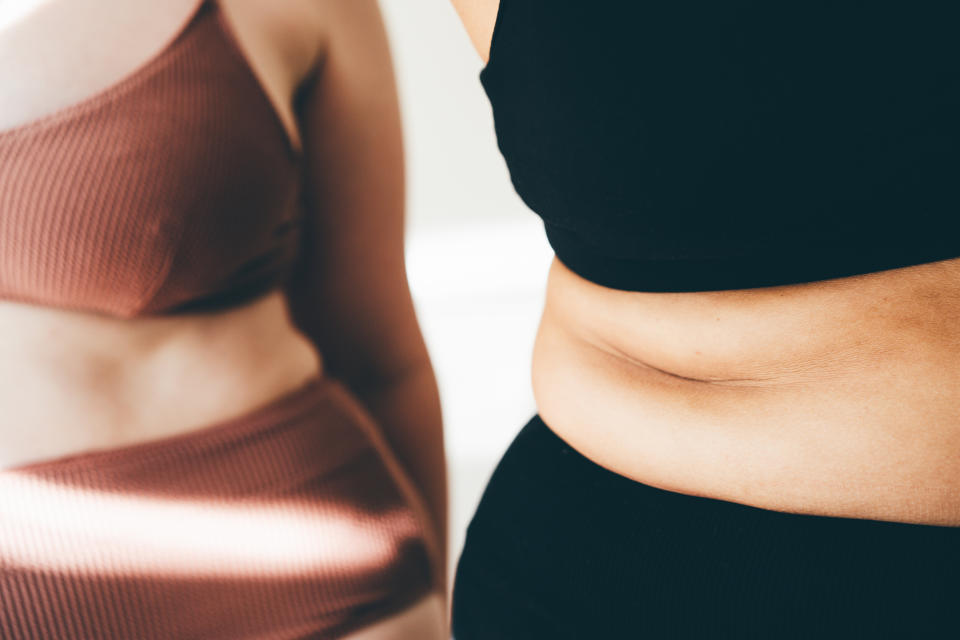Here’s The Real Reason Women Have That Little Pooch

When it comes to anatomy ― specifically female anatomy ― perhaps no part of the body has confused the internet quite so much as the belly pooch.
Any time someone posts about the fat women tend to carry around their midsection ― and a strange number of people do post about it ― others are quick to chime in that “it’s not fat, it’s the uterus.”
Take, for instance, earlier this year, when a man posted a few photos of the pooch on random women and said, “On behalf of all men, we hate this.”
The post blew up, and the man was rightly ridiculed for his dumb blanket statement. Plenty of men love the pooch and went to bat for it: ”[We] never authorized this clown to speak on our behalf,” one guy replied. Women reacted, too: “On behalf of women, we don’t give a damn.”
But as usual when these things get posted, many people weighed in to let the man know he was ill-informed: “That’s literally our uterus. Learn human anatomy,” one woman said.

The “stomach fat is literally the womb [or uterus]” is a persistent, popular claim: In 2020, health influencer and dietitian Colleen Christensen posted an image on her No Food Rules Instagram account reassuring her followers “that [the] bump at the bottom of your stomach is your uterus.”
Christensen shared how frustrated she was that she couldn’t get a flat stomach until a friend put her at ease by explaining that “that bump is organs.”
As Christensen soon learned from her comment section, that’s not really the case: Internal organs do take up space in your body, but the uterus ― a thick-walled, hollow organ where the fetus develops during pregnancy ― is located in the female pelvis between the bladder and rectum, not in the stomach. (To Christensen’s credit, she later updated her post with more information for her followers.)
Dr. Lisa Erlanger, a clinical professor of family medicine at the University of Washington School of Medicine, broke it down further for us in an email interview: “The bony part contains the uterus and ovaries,” she said. “The hips are wider and tilted differently for women, which naturally gives a different look, but the uterus typically isn’t in what we consider the stomach.”
There are also a lot of other body structures in that region that we need, said Dr. Stephanie Trentacoste McNally, the director of OB-GYN services at the Katz Institute for Women’s Health.
“In that part of our anatomy, there are many layers, from skin to fascia ― which is the strong tissue that holds you together ― muscle, nerves, blood vessels, connective tissue, and fat,” she told HuffPost.

But basically, your uterus isn’t contributing to a visible bulge unless you’re pregnant, postpartum, or have a tumor. Uterine fibroids, for instance, can cause the uterus to enlarge, leading to a noticeable bulge.
“The uterus is at least the size of a fist and can be larger with medical conditions like fibroids and endometriosis, and ovaries can have benign cysts that take up space,” Erlanger explained.
That said, various stages of the menstrual cycle can affect digestion and fluid balance, and that can change the appearance of the body, especially the abdomen, according to Erlanger.
If you’ve undergone surgery, the skin may heal in a way that creates a pooch, too, Trentacoste McNally said: For instance, about 30% of all babies in the U.S. are born via C-section and the scar from that procedure can pull skin and create a different shape abdominally.
Bottom line: You don’t need to justify the pooch.
The rush to explain away belly fat ― “It’s not fat; it’s actually something useful!” ― speaks to how ill at ease we are with body fat in general. The fact is it’s totally normal for women to have more fatty tissue in the stomach region compared with men.
“Under ovarian influence, the body does typically have a higher body fat percentage,” Erlanger said. “This is thought to serve the function of protecting reproduction.”
In menopause, belly fat is thought to protect bones, mood, sexual function and even brain and heart health by continuing to make small amounts of estrogen, she explained.
Regardless, though, there’s nothing wrong with belly fat just being belly fat.
“People without uteruses have tummy pooches, too, and the back of my arm has fat, and there’s no uterus there,” Erlanger said.
Weight fluctuations across our lifespans are very common, and in general it’s healthier to live in the body size and shape you have than to try to make it smaller or shaped differently, she added.
Bottom line, according to our doctors? It’s not OK to have a pooch because there’s a uterus there. It’s simply OK to have a tummy pooch.
“Having compassion for ourselves for having bodies and committing to caring for them as they are in ways that are responsive to our individual values, goals and circumstances is really part of the journey,” Erlanger said. This article originally appeared on HuffPost.


